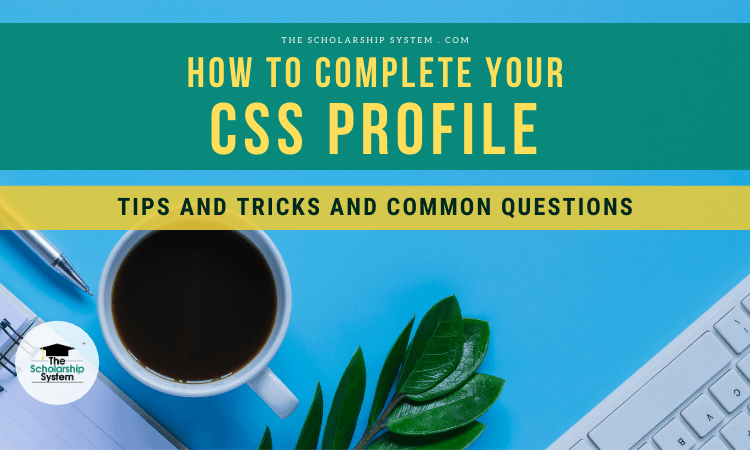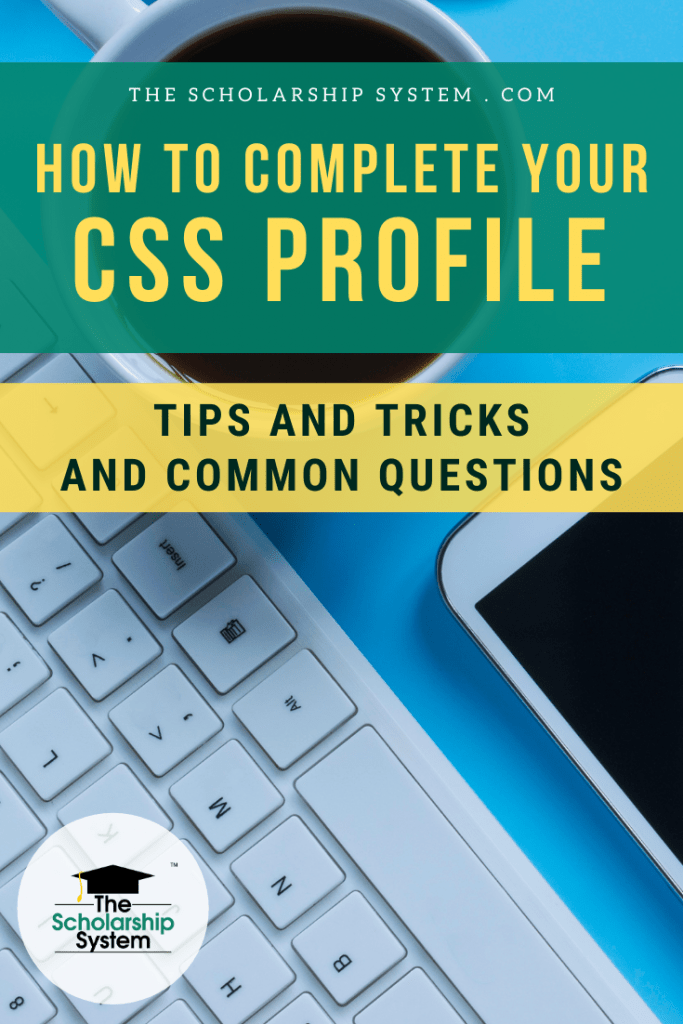Updated on October 27th, 2023
As your child begins exploring colleges and deciding where to apply, they may focus on a school that requires a CSS profile. In some cases, this takes students by surprise. While the CSS profile is widely used, it isn’t discussed as often as other application requirements, like the FAFSA.
However, that doesn’t mean your student can overlook CSS profiles. If they want to apply to a school that requires one, they’ll need to complete it. If your student is wondering what that entails, here’s a look at what a CSS profile is and when it’s due, along with some CSS profile tips and tricks.
If you and your student want to learn more about finding scholarships, sign up for our free college scholarship webinar! Take a trip over to http://thescholarshipsystem.com/freewebinar to reserve your spot today.
Contents
What Is the CSS Profile?
In the simplest sense, a College Board CSS profile is a financial aid application. It is used to award non-federal financial aid. It is separate from the FAFSA, which focuses on federal financial aid like Pell Grants, work-study, and Stafford Loans.
A CSS profile is not an alternative to the FAFSA, and the FAFSA is not an alternative to a CSS profile. These are two separate applications that serve two distinct purposes.
Along with potentially giving students more financial aid sources, a CSS profile also allows students to provide more in-depth information than the FAFSA alone covers. This creates an opportunity for students to develop a clearer picture of their own college financial aid situation and discuss any special circumstances that they are experiencing.
 When Is the CSS Profile Due?
When Is the CSS Profile Due?
The College Board CSS profile due date varies depending on the school. While most colleges have a due date between January 1 and March 31, some schools set theirs much earlier.
The earliest due date is generally November 1 and typically covers early decision students. For regular admissions, the earlier due dates are usually in January. However, each school gets to set their own deadlines. Students need to check with each college they are applying to if they want to know when the CSS profile deadline is for that institution.
Students are able to begin filling out their CSS profile on October 1, giving them one month to wrap up their profile before the earliest CSS profile deadline.
How Much Does a CSS Profile Cost?
Unlike the FAFSA, students do have to pay for an initial CSS application, which includes one report that can go to one college the student is interested in attending. For the 2021-2022 school year, that costs $25.
Plus, any additional reports beyond the initial application also come with a price tag. Each one is an extra $16.
However, some students qualify for a fee waiver. Typically, as long as your student is eligible for an SAT fee waiver, they won’t have to pay the CSS profile fees.
Even if your student didn’t receive an SAT fee waiver, they might still be eligible for a CSS Profile fee waiver, depending on your household’s income level. Generally, a family of four with an income of no more than $45,000 a year qualifies fee waivers. However, each student’s situation is unique, so it’s best to refer to the fee waiver details page and FAQs to check eligibility.
Who Has to Complete a CSS Profile?
Whether a student needs to complete a CSS profile depends on the college they plan to attend. Some schools make it mandatory. As a result, if your student plans on applying to one of those colleges, they’ll have to complete the profile and submit a report to that institution.
For students who aren’t applying to colleges that require one, completing a CSS profile for financial aid eligibility is unnecessary. If your student isn’t sure whether a school they are interested in makes these financial aid applications mandatory, they should review the college’s financial aid page, speak to the admissions department, or check the list available on the College Board website.
Colleges That Require a CSS Profile
There are over 400 colleges and universities that use CSS profiles, and new schools may be added every school year. Usually, it’s best for students to check the list of CSS profile schools on the College Board website directly, ensuring they have the most recent information.
With that in mind, here is an example list, featuring just a small fraction of the schools that use CSS financial and aid eligibility profiles as part of their processes:
- Baylor University
- Boston College
- California Institute of Technology
- Columbia University
- Cornell University
- Duke University
- Georgetown University
- Georgia Institute of Technology
- Harvard College
- Johns Hopkins University
- Massachusetts Institute of Technology
- Northwestern University
- Rice University
- Smith College
- Stanford University
- Tulane University
- University of Miami
- University of Notre Dame
- Vassar College
- Wake Forest University
- Yale University
Again, that list does not feature every school that may require a CSS profile, just a small part. Students should refer to the College Board site and the college’s financial aid office or admissions website to check and see if they may need to submit a CSS profile.
CSS Profile Mistakes to Avoid
As with all complex forms, it’s possible to make mistakes on a CSS profile. When that happens, it can cause a delay in college application processing or may hinder a student’s ability to secure financial aid they are eligible to receive. Most of the mistakes are avoidable, as long as your student knows to watch out for them.
One of the biggest missteps is applying for the wrong academic year. Some students accidentally select the year. Students need to choose the range that reflects when they are going to be attending college.
Many of the other mistakes have to do with typos or inaccurate information. For instance, Social Security numbers that aren’t correct can cause significant problems in processing.
Choosing the wrong student status is also a common error, as well as accidentally listing a parent’s details in spaces that are supposed to contain information about the student or vice versa.
In some cases, students accidentally send their reports to a graduate school instead of the institution’s undergraduate section. This causes the report to go to the wrong admissions area and can cause delays.
Some students also struggle if their parents are divorced or separated. A CSS profile may require details about both parents (and their households), making completing the application cumbersome.
The College Board does provide detailed instructions focused on students who have divorced or separated parents, including if they do not have any contact with their noncustodial parents. Students should refer to these resources to ensure they handle their profiles correctly.
How to Fill Out the CSS Profile
Filling out a CSS profile isn’t entirely unlike completing the FAFSA. Students need to provide information about themselves at a minimum, and most will need to include details about their parents, as well as family income.
Generally, students need to have access to the following resources and financial documents – for both themselves and their parents – to complete the application:
- Tax returns (for the 2022-2023 school year, 2020 and 2021 tax returns may be necessary)
- W-2 forms or other records that reflect current year income
- Records that show untaxed income and benefits for the current year and tax return years
- Recent bank statements
- Investment account records
- Trust account records
If your student has already created a College Board account – which is required to sign up for the SAT and view SAT, PSAT, and AP scores online – then they can use those credentials to begin completing their CSS profile. If not, the first step they need to handle is creating their College Board account.
Once they have a College Board account, they can begin completing their CSS profile on the College Board website. They’ll navigate through numerous sections, providing all required information. A wide variety of information is covered, including personal information about the student and their parents, as well as financial information.
After completing all of the required fields, your student can submit their application and complete the application certification. At that point, they can send their CSS profile to colleges whenever the need arises. They don’t have to send them out to every school immediately. If they decide to add a school later, they can select the new college, pay the fee, and send the report on its way.
If you and your student want to learn more about finding scholarships, sign up for our free college scholarship webinar! Take a trip over to http://thescholarshipsystem.com/freewebinar to reserve your spot today.








An additional step is IDOC. This is where you upload tax returns, W2s for both, parents and student.
Thank you for the helpful tips! Completing the CSS Profile can be a bit overwhelming, but your step-by-step guide made it much clearer. I especially appreciated the section on common questions, as it addressed some concerns I had. Looking forward to applying for more scholarships with your advice in mind!